
The New York City Police Department carried out an extensive national and international spying operation on protesters leading up to the Republican National Convention in 2004. On Sunday, The New York Times reported teams of undercover officers were sent across the nation, to Canada and to Europe to spy on groups and individuals planning to take part in the protests in New York. We speak with Jim Dwyer, the New York Times reporter who broke the story. [includes rush transcript]
Transcript
AMY GOODMAN: A new exposé has revealed the New York City Police Department carried out an extensive national and international spying operation on protesters leading up to the Republican National Convention in 2004. On Sunday, The New York Times reported teams of undercover officers were sent across the country, to Canada and to Europe to spy on groups and individuals planning to take part in the protests here in New York.
The officers were part of what was called the ”RNC Intelligence Squad.” Squad members posed as activists and filed daily intelligence reports on their activities. Some of the targets included street theater companies, church groups, antiwar organizations, environmentalists, musical artists and death penalty opponents. The intelligence was shared with police departments nationwide.
Today we’ll here from the New York Police Department, a civil liberties attorney and an activist who was subject to four pages of surveillance records. But first, I’m joined by the reporter who broke the story for The New York Times. Jim Dwyer joins us in our firehouse studio. Welcome to Democracy Now!
JIM DWYER: Morning.
AMY GOODMAN: Jim, lay it out for us.
JIM DWYER: OK. In 2003, New York City found out it was going to be the host of the—early 2003, found out it was going to be the host of the RNC, the Republican National Convention, in late August 2004. And part of their preparations included using the intelligence division to collect information about who was coming to the city to protest.
AMY GOODMAN: And who is the intelligence department?
JIM DWYER: Well, the intelligence division is a shifting body. It’s a group that—it’s a part of the police department that was expanded significantly after 9/11, when Commissioner Ray Kelly came in office. There were a lot of revelations about the national intelligence system being very threadbare and creaking and unable to communicate, from the FBI to—one branch of the FBI to another. And so, Kelly decided that the city needed its own intelligence capability, and he actually brought in a deputy commissioner from the CIA, a guy named David Cohen, to head up that effort.
The other thing that happened was the city began to take steps to loosen the restrictions that had been on surveillance of political groups as a result of a class-action lawsuit that was brought over a prior generation of—a prior iteration of the intelligence division. And that lawsuit had been filed back in 1971, and the restrictions were still in place. And they were guidelines under which—that said what circumstances the police could monitor political activity.
And so, in late 2002 and going into 2003, they sought to ease those restrictions. They’re simultaneously expanding the capacity of the intelligence division so that the city is more self-sufficient, I guess you would say. And when they got the convention, it was right around the time that these rules from this class-action lawsuit, which are known as the Handschu guidelines, were substantially eased. And so, the city basically set out to collect a lot of information with this newly muscular organization that was set up as a counterterrorism tool, but it became sort of a logistics and political protest assessment tool, as well. It would seem like a somewhat different function than it had really been set up for.
AMY GOODMAN: Explain how New York then related to the rest of the country.
JIM DWYER: Yeah. Well, New York was viewed by the police department as—and correctly—as a place that a lot of people were going to come to express their views during the convention. And so, the city set out—sent out detectives to, you know, more than a dozen states. They probably were in every major city in the country. And the undercover agents would pose as activists or sympathizers and, you know, basically infiltrate these groups to some extent.
And for how long, it’s not entirely clear. And, you know, how disruptive this infiltration was, we really don’t know, or if it was disruptive. But we do know that these detectives were, you know, sent all over the country. They went to Canada. They went to Europe, in some cases. And they filed reports back, and these reports were compiled into daily digests—not daily digests, weekly digests, and there was even a classification system set up. I think it was a little bit fanciful, but it was called ”NYPD Secret.” I don’t think that that has any particular meaning in law, but it was something that was set up to handle the documents that came in for the RNC.
AMY GOODMAN: They would be stamped ”NYPD Secret.”
JIM DWYER: They were stamped ”NYPD Secret.”
AMY GOODMAN: You write that police records indicate in addition to sharing information with other police departments, New York undercover officers were actually active themselves in at least 15 places outside of New York, including California, Connecticut, Florida, Georgia, Illinois, Massachusetts, Michigan, Montreal, New Hampshire, New Mexico, Oregon, Tennessee, Texas and Washington, D.C., not to mention Europe.
JIM DWYER: Yes, and, of course, the five boroughs of New York, yeah. So, the NYPD went all over the place. And the reason they did, the police say, is to get an idea of how many people were going to be coming and what their intentions were about how they would act when they got to New York.
AMY GOODMAN: Now, this is serious when you talk about infiltration, because you can also talk about provocateurs.
JIM DWYER: I don’t know anything about provocateurs. I mean, you know, I didn’t report anything about that, and I actually don’t know anything to that effect.
AMY GOODMAN: But that’s what it can lead to.
JIM DWYER: That’s right, yeah. It’s classified as—the NYPD guidelines, undercover agents are classified as an “intrusive tactic.” And the guidelines are meant to reflect that this is a very sensitive and powerful tool, particularly in the context of political investigations. And so, when the NYPD applied for this easing of the restrictions in 2002 and 2003, Mr. Cohen and others said, “Look, we’re going to be careful about how we use this authority, and we’re going to be, you know, stringent and”—well, I don’t want to say that word, “stringent,” but “We’re going to apply a series of reviews to make sure that it’s only applied in the appropriate circumstances.” And what are the appropriate circumstances? According to the guidelines and according to Judge Charles Haight, who oversees that case, there has to be some indication of unlawful activity for the police to launch an inquiry.
AMY GOODMAN: We’re talking to Jim Dwyer of The New York Times. You wrote a piece today that says the police say the documents should remain secret so the news media will not, quote, “fixate upon and sensationalize them,” hurting the city’s ability to defend itself in lawsuits over mass arrests.
JIM DWYER: Right. Well, actually, the NYPD didn’t say that.
AMY GOODMAN: You said—
JIM DWYER: I didn’t say it, no. The city lawyer said it. So, the city legal department made that assertion. The Times and the Civil Liberties Union, separately, are seeking to unseal these documents, and I understand the Civil Liberties Union is also seeking additional material now, as well. They are seeking some of the raw intelligence documents that underlay the digests.
What happened in the RNC cases, there’s a whole bunch of lawsuits going forward over the people who were arrested during the convention. And as part of that, earlier this year, the city turned over to the plaintiffs a big pile of the daily digests—or the weekly digests, as the case was. And now the Civil Liberties Union is seeking the underlying raw materials, the detective reports from the fields, that made up those daily digests. On a separate track, the Times has asked the judge to unseal the material that already has been turned over. The Civil Liberties Union is also asking for that material to be turned—unsealed.
AMY GOODMAN: The organizations, Jim Dwyer, that were surveilled, you talk about, for example, the War Resisters League.
JIM DWYER: Yeah.
AMY GOODMAN: What else? What other groups?
JIM DWYER: Well—
AMY GOODMAN: Environmental groups?
JIM DWYER: Billionaires for Bush was one.
AMY GOODMAN: Billionaires for Bush being the comic troupe.
JIM DWYER: Yes, Billionaires for Bush are not really billionaires for Bush. I just got—one of our photo editors was looking, was trying to understand the—I sent him an assignment saying we need a picture of this guy from Billionaires for Bush. And he said, “Why is there a group called—doesn’t everybody assume?” And anyway, we straightened that out. The Billionaires for Bush are a bunch of people who wear bow ties and tuxedos, and they go around with martini glasses and pretend to be supporters of the Bush administration. In fact, they issued a statement yesterday saying that they suspected they were under surveillance because the police were looking for stock tips from them. Billionaires for Bush. There were city councilmen who were listed in the reports because they were endorsing various press conferences or demonstrations.
AMY GOODMAN: You have the sponsors of an event planned for January 15, 2004, in honor of Reverend Dr. Martin Luther King Jr.’s birthday, were listed in one of the reports, which noted that it was a protest against, quote, “the RNC, the war in Iraq and the Bush administration.” It mentioned three members of the New York City Council at the time—Charles Barron, Bill Perkins and Larry B. Seabrook—who, quote, “have endorsed this event.”
JIM DWYER: Yes. Now, the NYPD also—although I have not seen these materials, but the NYPD says that it was also surveilling people with histories of violent acts. There’s a man who had a series of convictions for bombings back in the '70s who they say they were tracking. There were individuals they said had records of violence during other protests in Seattle, Genoa and other places, who they were—who they say they were watching, as well. I haven't seen the materials about those surveillance.
AMY GOODMAN: How did you get all of this information?
JIM DWYER: I was born on third base and thought I hit a triple, to quote Ann Richards. I’ve been reporting on this for a while, and a number of people thought it was important that I see it.
AMY GOODMAN: The other time that we had you on, Jim Dwyer, was on the issue of Critical Mass and the cyclists that rode through the city and the undercover surveillance of them. Did they fit into this story, Critical Mass?
JIM DWYER: Yes, Critical Mass and Time’s Up, there were reports on both of those groups, on their plans for various—that there was going to be a ride, a big ride before the convention, and also that the ride was expanding. I remember reading about that in some of these materials. And Time’s Up, which is associated with Critical Mass, was having a retreat or some kind of planning conference ahead of the convention, and that was described in some of the reports.
There was a march from—you’re sort of jogging my memory now, so I can remember a couple of other things. There was a march by a group of families who lost people in the 9/11 attacks, who were rolling a memorial block of granite, I think, from—I think from Boston down to New York. But it was some kind of march like that, and they said it was in commemoration of civilians who had been killed in wars throughout time. There was a report on them. There was the march from Boston to New York, I think it was RNC to DNC, that was included in their reports. There were groups that were planning civil disobedience in Syracuse, that was planning to step off the curb, step off curbs around Madison Square Garden, where the convention was going to be held, at a certain time. There was a report about that.
AMY GOODMAN: And the problem with there being a report about each of these things?
JIM DWYER: Well, I’m not saying there was a problem about it; I’m just telling you there were reports. That’s up for other people to decide whether it was a problem or not.
AMY GOODMAN: Well, in our next segment we will have a discussion, a debate, between New York Civil Liberties Union—and one of the people who you talked about, Joshua Kinberg, will be joining us in San Francisco.
JIM DWYER: Yeah.
AMY GOODMAN: Why don’t you give us a preview of who he is?
JIM DWYER: Joshua Kinberg was a graduate student at Parsons School of Design, and he devised this bicycle. I have to say it was just fabulous. It was like an earthbound skywriter. And on the back of the bicycle he had rigged up something that could squirt chalk, dots and dashes of chalk, so that as he went along on the street, he could print a message out. To add to the kind of drama of the thing, he had a laptop and a cellphone, and all of these things would work together. People would send in messages to his website, and they would get printed out through his chalk machine. And the thing actually worked, which is hard to believe.
He was—you know, they had several pages of material about him. There were a couple of pages of pictures about—of the bicycle and the gadget. And it said that, you know, the purpose of this, the sole purpose of this, the report said, sole purpose is protesting at the RNC and to print what they called “activist-type messages” on the street. And then he could make a fast getaway. But one of the intelligence reports noted that he was using water-based soluble chalk—sorry, water-soluble chalk, rather than paint, to avoid a criminal mischief charge.
And there was other groups that were—you know, it’s hard to know why, in some cases, the government had any interest in some of these people. There was a thing called “Bands Against Bush,” and they were having a series of concerts around the country on this particular day in October 2003. And there were going to be political videos in between the musical sets. And for some reason, this became a matter of interest to the intelligence division, and they decided to notify the police—I think it was in Seattle, Washington, San Francisco, a couple other—Chicago, maybe, a couple of other cities like that.
AMY GOODMAN: And were you able to gather all the different ways that they gathered the information?
JIM DWYER: No. I mean, I don’t think that—
AMY GOODMAN: What you could see from the documents.
JIM DWYER: Yeah, I mean, I think we’re—we don’t know a lot about this process yet. You know, I mean, we had a very long article in the newspaper, but in some ways it’s very schematic, you know? We’re talking about the map of a fairly large and significant operation. And there’s probably a lot of important things that we don’t know about it. And, you know, I think there’s probably things that the police department feels proud about, many, you know, that they feel were accomplishments, and they prevented crimes and things, that we don’t know about yet. Or maybe there aren’t. I don’t know what the answer is to that. But so far, we’re only seeing, you know, the first glimpses of this operation.
AMY GOODMAN: Well, Jim Dwyer, thanks very much for this exposé. We are going to follow up in our next segment with a debate between the police department and a civil liberties lawyer and Joshua Kinberg himself, the man on the bicycle, who only got it returned after a year. But we’ll talk about that in a minute. Jim Dwyer of The New York Times. This is Democracy Now!, democracynow.org. We’ll be back in a minute.

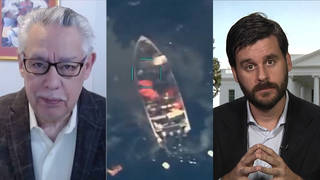
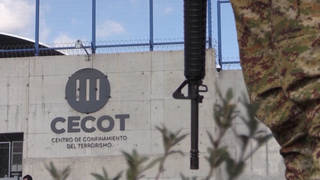
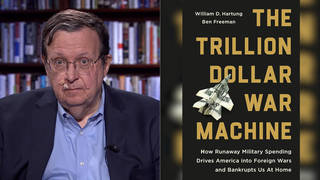
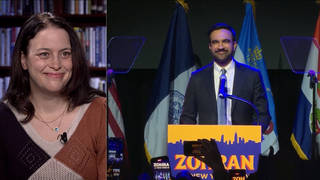






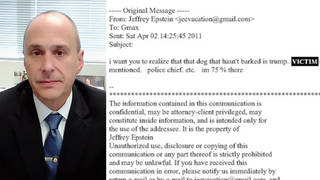
Media Options